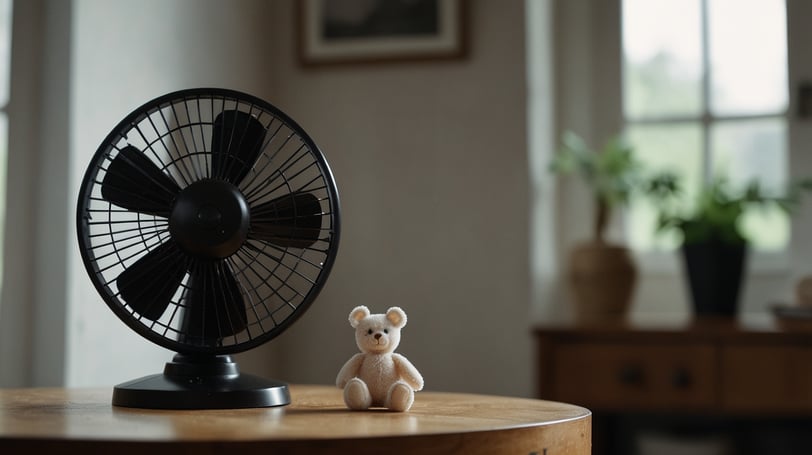The Importance of Proper Ventilation in Keeping Your Baby Cool
Learn how proper ventilation keeps your baby cool and comfortable. Essential tips for maintaining a healthy environment are covered.


When it comes to ensuring the comfort and health of your baby, proper ventilation is a crucial yet often overlooked aspect. Babies are particularly vulnerable to temperature changes and poor air quality, which can lead to discomfort, disrupted sleep, and even health issues. This comprehensive guide will explore why proper ventilation is essential for keeping your baby cool and provide practical tips for maintaining a well-ventilated environment.
Why Proper Ventilation Matters
Temperature Regulation
Babies are less capable of regulating their body temperature compared to adults. They can quickly become overheated, especially in warm weather or poorly ventilated spaces. Proper ventilation helps to maintain a consistent and comfortable temperature, reducing the risk of overheating and ensuring your baby stays cool.
Air Quality
Good ventilation ensures a continuous supply of fresh air, reducing the concentration of indoor pollutants and allergens. Poor air quality can lead to respiratory issues and discomfort, making it vital to keep the air clean and fresh for your baby’s health and well-being.
Sleep Quality
Babies need a lot of sleep for healthy development, and a comfortable sleeping environment is essential. A well-ventilated room helps regulate temperature and maintain air quality, contributing to better sleep quality and overall comfort for your baby.
Tips for Ensuring Proper Ventilation
Use Fans Strategically
Fans are an excellent way to improve air circulation in your baby’s room. Place them in positions that promote airflow without blowing directly on the baby. Ceiling fans are particularly effective as they distribute air evenly throughout the room. For added convenience, consider using a portable baby fan, which can be positioned to optimize airflow around the crib or play area.
Open Windows
Whenever possible, open windows to allow fresh air to circulate. This is especially important during cooler parts of the day, such as early morning or late evening. Ensure that windows are secured with screens to keep insects out and are opened safely to prevent any accidents.
Use Air Purifiers
Air purifiers can help remove allergens, dust, and pollutants from the air, creating a healthier environment for your baby. Choose an air purifier with a HEPA filter for the best results, and place it in the room where your baby spends most of their time.
Ventilate During Bath Time
Bathrooms can quickly become humid and stuffy during bath time. Ensure that the bathroom is well-ventilated by using an exhaust fan or opening a window. This helps to prevent the buildup of humidity, which can contribute to an uncomfortable environment for your baby.
Avoid Overcrowding the Room
Too much furniture and clutter can obstruct airflow and reduce ventilation. Keep your baby’s room simple and spacious, allowing air to circulate freely. This not only improves ventilation but also creates a safer and more comfortable space for your baby to move around.
Seasonal Considerations for Ventilation
Summer
During the hot summer months, it’s especially important to keep your baby’s room well-ventilated. Use fans and open windows during the cooler parts of the day, and consider using blackout curtains to keep the room cooler. Ensure that your baby is dressed in lightweight, breathable fabrics to help them stay cool.
Winter
In winter, maintaining good ventilation can be challenging due to the need to keep the room warm. Use a humidifier to add moisture to the air, which can help maintain comfort without overheating. Open windows for short periods to allow fresh air in, and ensure that your heating system is clean and functioning properly to prevent the circulation of dust and allergens.
The Role of Crib Placement
Where you place your baby’s crib can significantly impact ventilation. Avoid placing the crib directly next to a window or against an exterior wall, where temperature fluctuations can be more pronounced. Instead, position the crib in a central location within the room, away from direct drafts but still within the path of circulating air.
Creating a Cross-Breeze
Creating a cross-breeze is an effective way to enhance ventilation. This involves opening windows on opposite sides of the room or house to allow air to flow through. If your baby’s room has windows on two walls, open both to create a natural flow of air. If not, use a fan to help draw air from one side of the room to the other.
Monitoring Humidity Levels
Maintaining the right humidity level is crucial for your baby’s comfort. Too much humidity can make the room feel stuffy, while too little can dry out your baby’s skin and respiratory tract. Aim for a humidity level between 40-60%. Use a hygrometer to monitor the humidity levels and adjust as needed with a humidifier or dehumidifier.
The Importance of Regular Maintenance
Regular maintenance of your home’s ventilation systems is essential for ensuring they function effectively. This includes cleaning and replacing filters in air conditioners, heaters, and air purifiers. Dust and allergens can accumulate in these systems, reducing their efficiency and potentially circulating contaminants back into the room.
Ventilation During Travel
When traveling, it’s important to consider ventilation in your baby’s sleeping environment. Whether you’re staying in a hotel or with family, ensure the room is well-ventilated. Portable fans can be a great solution for improving airflow in unfamiliar environments. Additionally, dress your baby in lightweight, breathable clothing to help them stay comfortable.
Proper ventilation is a fundamental aspect of creating a comfortable and healthy environment for your baby. By maintaining good airflow and air quality, you can ensure your baby stays cool, sleeps better, and enjoys a healthier living space. Implementing the tips and strategies outlined in this guide will help you achieve optimal ventilation, providing your baby with the best possible conditions for growth and development.
For an easy and effective way to enhance ventilation in your baby’s room, consider investing in a portable baby fan:
